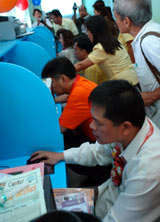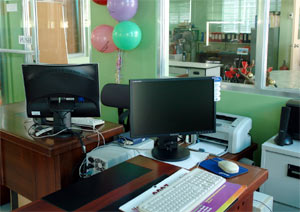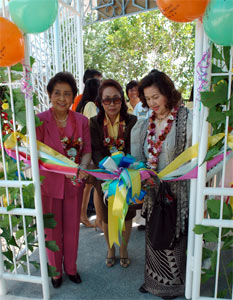UNESCO-supported e-center for disaster communication in the Philippines
27-04-2007 (Tacloban City)

Guests try out the facilities of the
e-Center for Disaster Management
© AIJC
Information is the most crucial element in risk and disaster situations is one of the important lesson that health officials gained from the landslide that buried Barangay Guinsaugon, St. Bernard, Southern Leyte in the Philippines in February 2006.
Access to information would have allowed individuals and an entire community to make the best possible decisions about their well-being within the soonest possible time and advance a behaviour or action that would allow for a rapid recovery from the event.
But health officials from Eastern Visayas recalled that it took a few days after the disastrous landslide that caused the death of more than a thousand residents (mostly women and children) before they were able to link and coordinate with the “outside world” for updating and mobilizing needed support. GTZ, an international cooperation enterprise owned by the German Federal Government, provided the only Internet link in the disaster site. Government agencies and NGOs using the facility had to cue to send their reports to Manila and other designations.
This slow pace in sending and exchanging risk, emergency and disaster information on health in Eastern Visayas may now be a thing of the past. On 26 March 2006, the Department of Health Eastern Visayas Regional Office inaugurated its Regional Electronic Access to Communication for Health in Eastern Visayas (REACH-EV).
The setting up of the Center was made possible with a US$50,000.00 grant from the UNESCO Emergency Assistance Programme.
According to Benita N. Pastor from the Department (Ministry) of Health Regional, REACH-EV will serve as electronic databank on health emergency management information in Eastern Visayas. It’s a “one-stop shop” that provides basic data services such as web browsing, e-mail and SMS, and serves as a databank on hazards and disasters in the region. It will facilitate electronic exchange among the eight provinces and the different municipalities in the region. REACH-EV is also envisioned to be a library for information materials on various formats on health emergencies and disasters. The 80 sq.m center will also serve as venue for ICT learning for health workers and community members. Pastor assured that REACH-EV will also cover other health issues and concerns of the region.
To prepare regional and provincial health officials, local officials and local community leaders on the use of the electronic center, DOH Eastern Visayas will conduct a series of training on disaster management, disaster communication, web page management, and digital literacy. The training series is part of the UNESCO grant and will be implemented in cooperation with the UNACOM, Asian Institute of Journalism and Communication (AIJC) and Commission on Information and Communications Technology (CICT). The initial training on disaster management was held on March 27 – 29 attended by provincial, municipal and barangay (village) health and disaster management officials. Meanwhile, the training on disaster communication will involve simulated exercises involving health officials and personnel at all levels, from barangays to regional offices. Other government agencies and NGOs will also be involved in the training.
DOH Eastern Visayas will also produce electronic content on disaster management that will be available through the web and CD-ROM. According to UNACOM Commissioner Florangel Rosario-Braid, the content will be based on lessons and experiences of the region in dealing with various forms of natural disasters. In addition to the Guinsaugon tragedy, another major natural disaster was the Ormoc flashflood in 1991 that killed over 5000 individuals. The e-content will be shared not only with health offices nationwide but with other Asia Pacific countries as well. This content development component is linked with the e-Knowledge Public Domain Project of UNACOM in cooperation with AIJC, CICT and Intel Microelectronics with support from UNESCO.
DOH officials from the central office also participated in the inauguration through teleconferencing made possible with the new equipment and facilities acquired through the UNESCO grant. DOH undersecretary Margarita Galon challenged local health officials to serve as model for other regional health centers nationwide in the use of electronic media for disaster preparation and management. The e-Center can also be a model for other Asia-Pacific countries.
by Ramon R. Tuazon
But health officials from Eastern Visayas recalled that it took a few days after the disastrous landslide that caused the death of more than a thousand residents (mostly women and children) before they were able to link and coordinate with the “outside world” for updating and mobilizing needed support. GTZ, an international cooperation enterprise owned by the German Federal Government, provided the only Internet link in the disaster site. Government agencies and NGOs using the facility had to cue to send their reports to Manila and other designations.
This slow pace in sending and exchanging risk, emergency and disaster information on health in Eastern Visayas may now be a thing of the past. On 26 March 2006, the Department of Health Eastern Visayas Regional Office inaugurated its Regional Electronic Access to Communication for Health in Eastern Visayas (REACH-EV).
The setting up of the Center was made possible with a US$50,000.00 grant from the UNESCO Emergency Assistance Programme.
According to Benita N. Pastor from the Department (Ministry) of Health Regional, REACH-EV will serve as electronic databank on health emergency management information in Eastern Visayas. It’s a “one-stop shop” that provides basic data services such as web browsing, e-mail and SMS, and serves as a databank on hazards and disasters in the region. It will facilitate electronic exchange among the eight provinces and the different municipalities in the region. REACH-EV is also envisioned to be a library for information materials on various formats on health emergencies and disasters. The 80 sq.m center will also serve as venue for ICT learning for health workers and community members. Pastor assured that REACH-EV will also cover other health issues and concerns of the region.
To prepare regional and provincial health officials, local officials and local community leaders on the use of the electronic center, DOH Eastern Visayas will conduct a series of training on disaster management, disaster communication, web page management, and digital literacy. The training series is part of the UNESCO grant and will be implemented in cooperation with the UNACOM, Asian Institute of Journalism and Communication (AIJC) and Commission on Information and Communications Technology (CICT). The initial training on disaster management was held on March 27 – 29 attended by provincial, municipal and barangay (village) health and disaster management officials. Meanwhile, the training on disaster communication will involve simulated exercises involving health officials and personnel at all levels, from barangays to regional offices. Other government agencies and NGOs will also be involved in the training.
DOH Eastern Visayas will also produce electronic content on disaster management that will be available through the web and CD-ROM. According to UNACOM Commissioner Florangel Rosario-Braid, the content will be based on lessons and experiences of the region in dealing with various forms of natural disasters. In addition to the Guinsaugon tragedy, another major natural disaster was the Ormoc flashflood in 1991 that killed over 5000 individuals. The e-content will be shared not only with health offices nationwide but with other Asia Pacific countries as well. This content development component is linked with the e-Knowledge Public Domain Project of UNACOM in cooperation with AIJC, CICT and Intel Microelectronics with support from UNESCO.
DOH officials from the central office also participated in the inauguration through teleconferencing made possible with the new equipment and facilities acquired through the UNESCO grant. DOH undersecretary Margarita Galon challenged local health officials to serve as model for other regional health centers nationwide in the use of electronic media for disaster preparation and management. The e-Center can also be a model for other Asia-Pacific countries.
by Ramon R. Tuazon
 Interior of the UNESCO-funded e-Center for Disaster Management
Interior of the UNESCO-funded e-Center for Disaster Management© AIJC
 Inauguration of the e-Center for Disaster Management
Inauguration of the e-Center for Disaster Management© AIJC
Related themes/countries
· Philippines
· Community Media
· Access to Information: News Archives 2007
· Content Development: News Archives 2007
· Media Development: News Archives 2007
Share this story:
Contact information
-
Contact
- Ramon R. Tuazon, Asian Institute of Journalism and Communication, Vice President, Research and Development and Consultancy
- AIJC
Source















